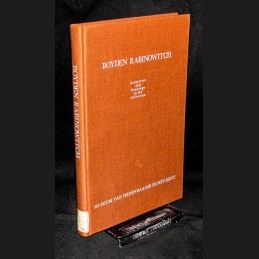Rabinowitch, Royden,
Sculptures and drawings in the collection. Gent: Musem van Hedendaagse, 1984. 191 Seiten mit Abbildungen. Leinen. 4to. 764 g
* Englisch/Niederländisch. Catalogue of the exhibition in the Museum van Hedendaagse Kunst-Gent, (24.11.1984-5.1.1985). - Rücken unten mit Registraturschild, Bibliotheksexemplar, diverse Registraturnummern und Stempel.
Bestell-Nr.157222
Rabinowitch |
Graphik |
Bildhauerei |
Plastik |
Sculpture |
Kunstausstellung |
Ausstellungskatalog
THE SCULPTURES OF ROYDEN RABINOWITCH A DISCOVERY
For Royden Rabinowitch sculpture has to do with a non-anthropomorphic body, in fact with an "internally determined body". It is significant that Royden Rabinowitch is now credited with the first casually balanced construction in sculpture, with his "Barrel Constructions" in 1964. A succession of balances completes the Barrel Construction. This process is based on the internal notion of duration, which is the idea of time passing through the body. (The sense of duration is the result of the observer collecting a succession of events outside the body and internalising them.) The internal nature of the "Barrel Constructions" establishes a great repose and inertness and Royden Rabinowitch concluded that these "internally determined bodies" were not articulated. The question of constructing an internally determined and fully articulated body then naturally arose. This question was not directly answered. The sculptor had to make constructions that had to do with internal conditions or conditions that were obscured by surfaces. The "Grease Cone" is an example of such an internal construction. The observer becomes aware that the straight side of the cone of grease must be supported by some internal structure as solid grease would not maintain a straight line. Royden Rabinowitch was aware of this fact because of his knowledge of materials. He generalised this awareness to conclude that internal conditions generally would be revealed by the observer's ability to act in space, because our knowledge of materials could be generalised to read "act in space". He realised that properties limiting the ability to act in space are well known as the somatic properties: closedopen, backfront, handed, all directions (vertical, horizontal, oblique), total asymmetry through 3 axes, (topbottom properties), top different from the bottom.
Again, Royden Rabinowitch could not construct with this awareness a "fully articulated, internally determined body" although he knew that construction should include the somatic properties. He had to return to the considerations of the "Barrel Constructions", namely that the'constructions are based on duration and that duration per se is not articulated. He concluded that an external corresponding notion to duration would be a succession of events unified and that articulation would be a dimensional judgement on the succession. The notion of a manifold as a "continuum in parts" naturally arose and the possibilities of constructing a "fully articulated, internally determined body" became apparent; the addition of a dimension to a manifold would in fact include the somatic properties. The construction was also seen to involve the two articulations of the body: adding and bending.
So, it is easy to conclude that as Giacometti's bodies were the last fresh modeled figurative sculptures and as David Smith's bodies were the last fresh anthropomorphic constructions, Royden Rabinowitch's bodies are the last fresh constructed non-anthropomorphic bodies. From Michelangelo to Bernini, to Rodin, to Brancusi, to Giacometti, to David Smith, to Royden Rabinowitch, we see great artists involved in unique sculptural solutions of the mysteries of the body. All these great sculptors make clear the notion of the sculpture maintaining its independence and anonymity regarding the observer.
Thus the observer feels free to discover his own independence on looking at the sculpture. The sculptures of Royden Rabinowitch accomplish an interaction between the intrinsic qualities of the sculpture as an autonomous entity and the observer's autonomous being. These sculptures operate internally to reveal a new structural stasis and thus establish the preeminence of the observer's location. This emphasizes finally that great sculpture is not only a concrete phenomenon but a spiritual entity refusing all analysis.
Jan Hoet






 Datenschutz
Datenschutz
 Versandkosten
Versandkosten
 Google Mail
Google Mail
